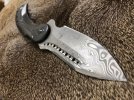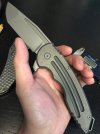- Joined
- Jul 30, 2006
- Messages
- 44,363
i do dig the look of it but in reading about the original purpose (i remembered my old man calling it a blood groove which it totally was not for that) i guess it was to strengthen the ridge above it, which seems counterintuitive but turns out is based in engineering.
Close. The original purpose of a fuller was to stiffen a sword.
Marbles brought the concept of a indentation to a hunting knife blade on their original "Ideal" model. It was a wide indentation and was there so that the blade would line up on a sharpening stone at the correct angle. They called it their "ideal" blade. From there the indentation got reinterpreted and narrowed back to look like a fuller on a sword. As such it became cosmetic on a knife blade. And it still is. Below I have referenced a post from Bernard Levine. It's not the only time he mentioned it.
https://www.bladeforums.com/threads/marbles-haines-hunting-knife-on-ebay.957281/#post-10889148

















